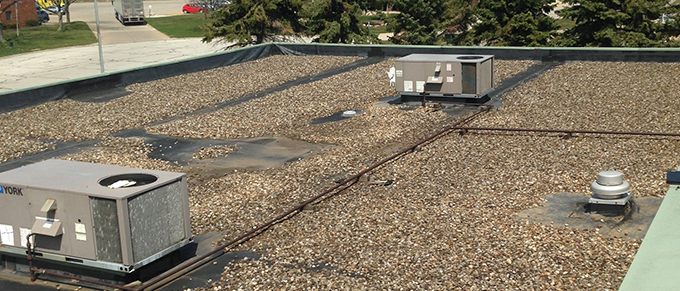
Ballasted commercial roof systems have been around since the 1970s. Many new roofing systems have come along since these loose-laid systems were introduced, so it’s easy to dismiss ballast as an outdated roofing system. Nothing could be further from the truth.
While ballasted roofs are similar to built-up roofs, Roberts Roofing professionals use much larger stones (at least one inch in diameter), and the stones are what hold the components in place. In other words, we can put everything together without the need of fasteners to hold components to the roof deck or to each other—the ballast is placed directly on the roof membrane to weigh it down. The layer that provides the waterproofing is attached to the roof edges and at specific penetration points.
So why have ballasted systems continued to thrive with so many other systems coming along?
Here are the top 6 reasons:
- Price: As we’ve already addressed, there is no need for fasteners and adhesives required by other roofing systems that cuts down on the cost and time for installing a ballasted roof.
- Labor and time savings: Ballasted roofs are easy to install—that decreases the risks of delays and makes for a smooth construction schedule. For the most part, roofing membranes can be installed using large sheets, so the job can go down fairly easily in most weather conditions.
- Durability: With almost four decades of documented performance records, there is no question that ballasted roofs last a long time. When they do need repairs, they are fairly straightforward and easy to make. Pavers keep the waterproofing layer safe from foot traffic, UV rays and weather conditions that might damage it.
- Aesthetics: You have to admit that ballasted roofs offer a pleasing texture, which are nicely combined with pavers as walkways.
- Safety: No gypsum board is necessary! Since rocks don’t burn, it’s fairly easy to achieve Class-A fire resistance without the need for expensive, fire-retardant chemicals in the EPDM rubber.
- Sustainability: Ballast can be reused and reused. Because it is not embedded in adhesive, it can be replaced after a membrane is repaired or replaced.
Skeptics may wonder how 10 pounds of gravel can 1) keep the roof on, and 2) not blow off and cause damage. Keep in mind that ballast stone is a far cry from common roofing gravel—there’s a big difference between the aggregate used as asphalt in built-up roofing (BUR) and stones and other materials used to ballast single-ply.
Ballasted roofs aren’t perfect—they can make leak detection difficult and the heavy stone can be difficult to move around for roof inspections. They offer commercial building owners many benefits and capabilities as a well-established option for flat roofs.
Roberts Roofing Company has been a leading provider of innovative commercial and industrial roofing solutions in Cleveland, Ohio since 1981. We provide commercial repair, replacement and maintenance to serve companies of all sizes in Ohio and the surrounding region, offering a combination of technical expertise, custom solutions and quality workmanship to every project.
To find out more about selecting a commercial roofer in Cleveland, Ohio, simply fill out the form on this page and a member of our team will be in touch. Or, you may call us at 440.946.2233.
